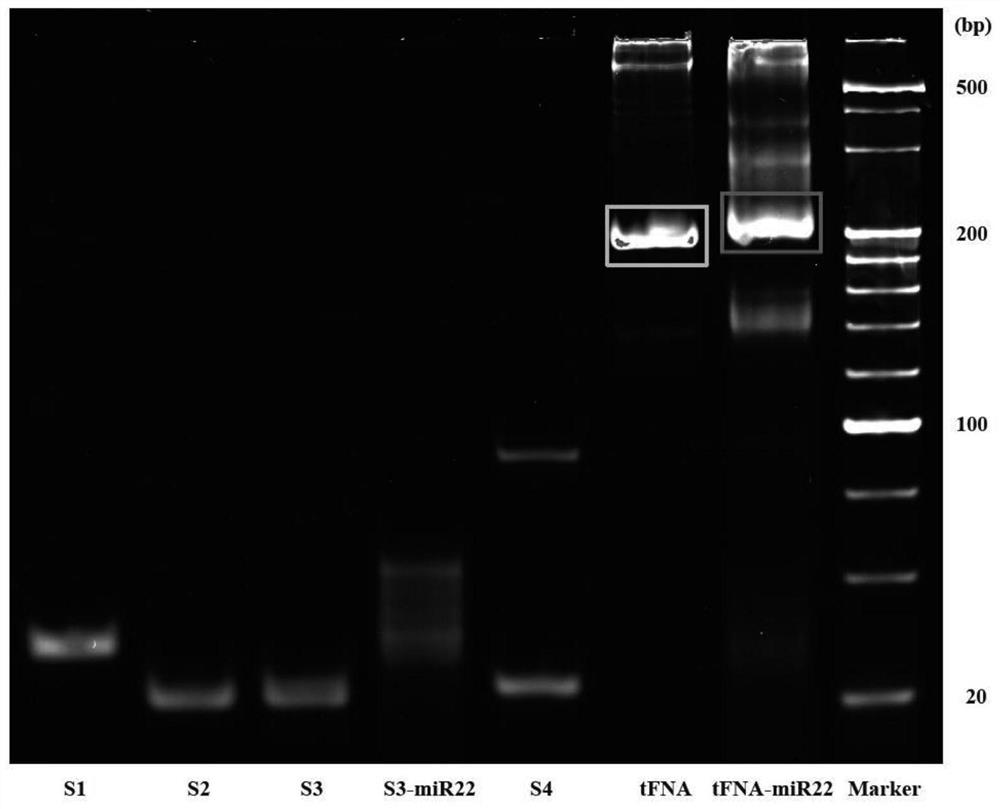A compound for treating optic nerve disease and its preparation method and use
A complex and optic nerve technology, applied in the field of biomedicine, can solve the problems of the protection effect of DNA tetrahedron on the optic nerve, the use of compound, and the undisclosed use of miR-22, etc., and achieve good application prospects and promote release. Effect
- Summary
- Abstract
- Description
- Claims
- Application Information
AI Technical Summary
Problems solved by technology
Method used
Image
Examples
Embodiment 1
[0048] Example 1. Synthesis of the complex of tFNA and miR-22 (tFNA-miR22)
[0049] 1. Synthesis
[0050] Dissolve the four DNA single strands (S1, S2, S3-miR22, S4) in TM Buffer (10mM Tris-HCl, 50MmMgCl2, pH=8.0), the final concentration of the four DNA single strands is 1000nM, mix well, and heat rapidly to 95°C for 10 minutes, then rapidly cooled to 4°C and maintained for more than 20 minutes to obtain tFNA-miR22.
[0051] The sequence of the four single strands (5'→3') is as follows:
[0052] S1:
[0053] ATTTATCACCCGCCATAGTAGACGTATCACCAGGCAGTTGAGACGAACATTCCTAAGTCTGAA
[0054] (SEQ ID NO. 1)
[0055] S2:
[0056] ACATGCGAGGGTCCAATACCGACGATTACAGCTTTGCTACACGATTCAGACTTAGGAATGTTCG
[0057] (SEQ ID NO. 2)
[0058] S3-miR22-3p:
[0059] AAGCUGCCAGUUGAAGAACUGU-TTTTT-ACTACTATGGCGGGTGATAAAACGTGTAGCAAGCTGTAATCGACGGGAAGAGCATGCCCATCC
[0060] S4:
[0061] ACGGTATTGGACCCTCGCATGACTCAACTGCCTGGTGATACGAGGATGGGCATGCTCTTCCCG
[0062] (SEQ ID NO. 4)
[0063] The 5' end of S1 is op...
experiment example 1
[0070] Experimental Example 1. Uptake of tFNA-miR22 by injured retinal ganglion cells
[0071] 1. Experimental method
[0072] 1.1 Testing the optimal modeling concentration (simulating optic ganglion cell damage in vitro)
[0073] RGC-5 cells (a mouse retinal ganglion cell) were grouped and cultured in 96-well plates, 1*10 per well 4 cells. Each group was treated with different concentrations of N-methyl-D-aspartic acid (NMDA) for 1 h, then changed to complete medium and continued to culture for 24 h. Then, the cell activity was detected by CCK-8 experiment, and the drug inhibition rate of 4 mM NMDA was found. is about 40%, so 4mM was chosen as the optimal modeling concentration (such as Image 6 :A-B).
[0074] 1.2 Test the optimal anti-cell damage drug concentration (cell proliferation experiment)
[0075] RGC-5 cells were grouped and cultured in 96-well plates, 1*10 per well 4 cells. After adding 4nM NMDA to each experimental group except the blank group and treatin...
PUM
| Property | Measurement | Unit |
|---|---|---|
| particle diameter | aaaaa | aaaaa |
Abstract
Description
Claims
Application Information
 Login to View More
Login to View More - R&D
- Intellectual Property
- Life Sciences
- Materials
- Tech Scout
- Unparalleled Data Quality
- Higher Quality Content
- 60% Fewer Hallucinations
Browse by: Latest US Patents, China's latest patents, Technical Efficacy Thesaurus, Application Domain, Technology Topic, Popular Technical Reports.
© 2025 PatSnap. All rights reserved.Legal|Privacy policy|Modern Slavery Act Transparency Statement|Sitemap|About US| Contact US: help@patsnap.com



